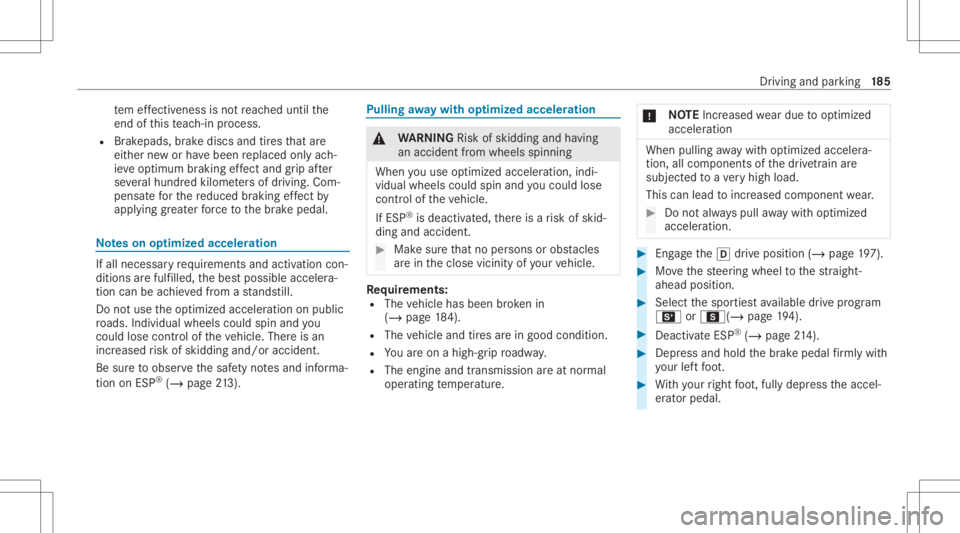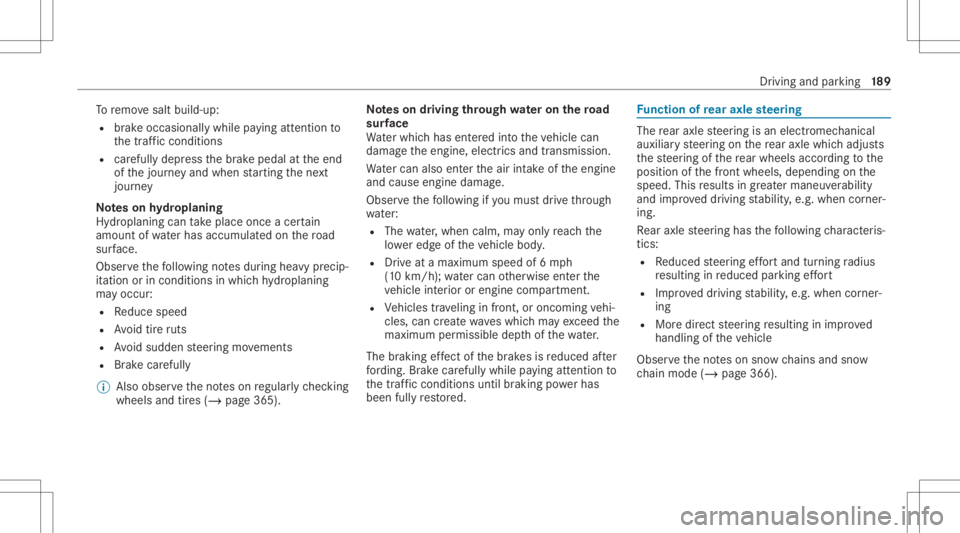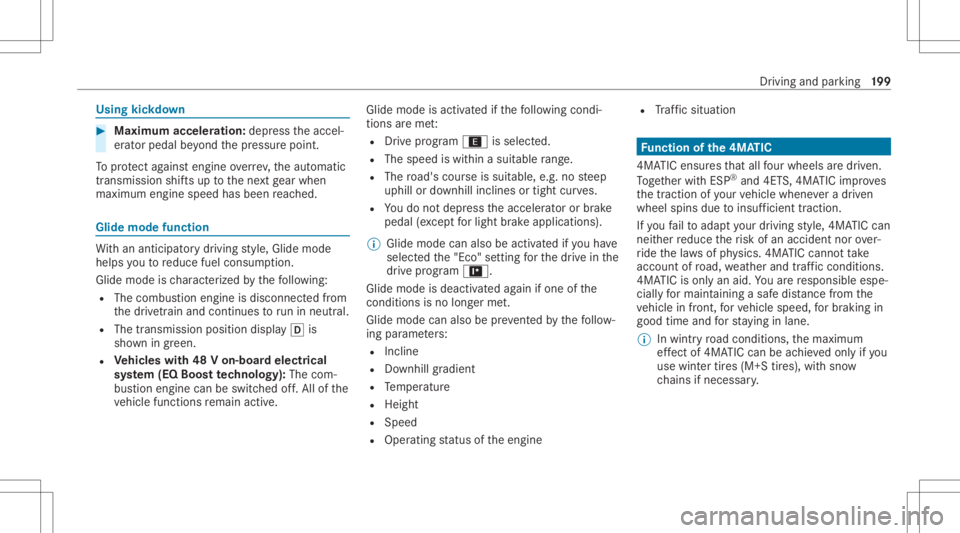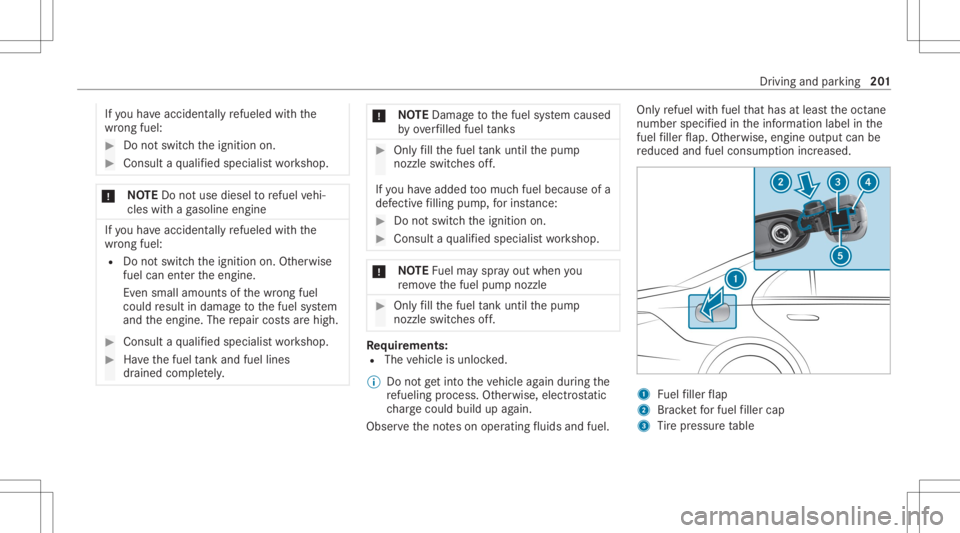2022 MERCEDES-BENZ S CLASS tire
[x] Cancel search: tirePage 71 of 610

Secur
ingthech ild restra int system withth e
seat beltonthefront passeng erseat
When installing abelt- secur edchild restra int
sy stem onthefront passeng erseat, always
obser vethefo llo wing:
0073 Obser
vetheno teson rear wa rd-faci ng and
fo rw ard-f acin gch ild restra int systems on
th efront passeng erseat (/page68).
0073 Obser
vethech ild restra int system manuf ac‐
tur er's installation andopera tingins truc‐
tion s.
0073 When
usingafo rw ard-f acin gch ild restra int
sy stem inwe ight categor yI: re mo vethe
head restra int from there spectiv eseat, if
possible .
Af terth ech ild restra int system has been
re mo ved, replace thehead restra int sag ain
immed iatelyand adjus tth em correctly .
0073 The
backrest of thefo rw ard-f acin gch ild
re stra int system mus t,as faras possi ble,be
re sting ontheseat backres tof thefront
passeng erseat.
0073 If
th ehead restra int ofthech ild seat cannot
be fullyex tende dwh en itis ins talled inthe ve
hicle, this will result inrestrictions onthe
maximu msize setting forch ild restra int sys‐
te ms inwe ight categor yII or III.
Cont actwithth ero of when thehead
re stra int isfull yex tende dand lock ed in
place willnotre sult inanyre strictions on
us e.
0073 The
child restra int system mus tno tbe put
under stra in be tween thero of and theseat
cushion and/orbeinstalled facing the
wr ong direct ion.
0073 The
child restra int system mus tno tbe put
under stra in by thehead restra int .Ad jus t
th ehead restra int sas appr opriate.
0073 Ne
verpla ceobjects (e.g.cushi ons)under or
behi ndthech ild restra int system.
The seat beltonthefront passeng erside is
eq uipped withach ild seat safetyfe atur e.
When enabled,thech ild seat safetyfe atur e
ens ures that theseat beltdoes notslac kenonce
th ech ild seat issecur ed(/ page63). #
Setth efront passeng erseat asfarbac kas
possi bleand movetheseat intoth ehighes t
position ifpossible. #
Fully re tract theseat cushion lengthadjus t‐
ment . #
Adjus tth eseat cushion inclination sothat
th efront edgeof theseat cushion isin the
highes tposition andthere ar edg eof the
seat cushion isin thelowe stposition . #
Setth eseat backres tto themos tve rtical
posit ionpossible . #
Installth ech ild restra int system.
The entire base ofthech ild restra int system
mus talw aysre st on thesitt ing surface ofthe
fr ont passeng ersea t. #
Alw aysmak esur eth at theshoulder belt
st ra pis cor rectly routed from theseat belt
outle tof theve hicle totheshoulder belt
guide onthech ild restra int system.
The shoulder beltstra pmus tbe routed for‐
wa rdsand down wardsfrom theseat beltout‐
le t. #
Ifneces sary,adjus tth eseat beltoutle tand
th efront passeng erseat accor dingly. Occupant
safety 69
Page 187 of 610

te
m effectiv enes sis no tre ac hed untilth e
end ofthis teac h-in proce ss.
R Brak epads, brak edisc sand tires that are
eit her newor have been replaced onlyac h‐
ie ve optimum braking effect and grip afte r
se veralhundr edkilom eter sof driving. Com‐
pensat efo rth ere duced braking effect by
appl ying great erforc eto thebr ak epedal. No
teson optimiz edacceler ation If
all necess aryre qu iremen tsand activation con‐
dition sar efulf illed, thebes tpossible accelera‐
tion canbeachie vedfrom ast ands till.
Do notuse theop timiz edaccelera tiononpublic
ro ads. Individ ualwheels couldspin andyou
cou ldlos econtr olof theve hicle. Thereis an
incr eased risk ofskidding and/oraccident.
Be sureto obser vethesaf etyno tesand informa‐
tion onESP ®
(/ page21 3). Pu
lling away wit hop timi zed accel eration &
WARNIN GRisk ofskid ding and having
an acci dent from whe elsspi nning
Whe nyo uuse optim izedacc eler ation,ind i‐
vidual wheelsco uld spin andyouco uld lose
co ntro lof theve hicle.
If ESP ®
is deactiv ated, ther eis arisk ofskid‐
ding andaccident. #
Mak esur eth at no per son sor obs tacles
ar ein theclose vicinit yof your vehicle. Re
quirement s:
R The vehicle hasbeen brok en in
(/ page18 4).
R Theve hicle andtires arein good condition.
R Youar eon ahigh -grip ro adw ay.
R The engine andtransmission areat nor mal
oper ating temp eratur e. *
NO
TEIncr eased weardue tooptimized
acceler ation When
pulling away wit hop tim ized acceler a‐
tio n,all com ponentsof thedr ivet ra in are
subje cted toave ry high load.
This canlead toinc reased component wear. #
Donotalw ayspull away wit hop tim ized
acc eleration. #
Engage the005B drive position (/page19 7). #
Movethesteer ing wheel tothest ra ight -
ahead position. #
Selec tth espor tiestav ailable drive pr ogram
B orC(/ page19 4). #
Deactiv ateESP ®
(/ page21 4). #
Depr essand hold thebr ak epedal firm lywith
yo ur leftfo ot . #
With your right foot ,full ydepr esstheaccel‐
er ator pedal. Dr
iving andparking 18
5
Page 191 of 610

To
remo vesalt build-up:
R brak eoccasionally whilepaying attention to
th etra ffic con dition s
R carefull ydepr essthebr ak epedal attheend
of thejour neyand when star tin gth ene xt
jour ney
No teson hydropl aning
Hyd roplaning cantake place onceacer tain
amount ofwa terhas accumu lated on thero ad
sur face.
Obs erve thefo llo wing notesdur ing heavyprecip‐
it ation orinconditions inwhic hhy droplaning
ma yocc ur:
R Reduce speed
R Avoid tireru ts
R Avoid sudden steer ing movements
R Brak ecar eful ly
% Alsoob ser vetheno teson regular lych ecking
wheels andtires (/ page365). No
teson driving through wateron the road
sur face
Wa terwhi chhas entered intoth eve hicle can
damag eth eengine, electricsand transmission .
Wa tercan alsoent ertheair intakeof theengine
and cause engine damage.
Obser vethefo llo wing ifyo umus tdr ive th ro ugh
wa ter:
R The water,when calm,ma yonl yre ac hth e
lo we redg eof theve hicle body.
R Drive at amaximum speedof6mp h
(1 0 km/ h);watercan other wise enterthe
ve hicle interior orengine compartment .
R Vehicles trave ling infront ,or onc omin gve hi‐
cles, cancreat ewav eswhic hma yex ceed the
maximu mper missi bledep thofthewa ter.
The braking effect of thebr ak es isreduced afte r
fo rd ing. Brak ecar efull ywhile paying attent ion to
th etraf fic condi tions untilbr aki ng powe rhas
been fullyrestor ed. Fu
nction ofrear axle steer ing The
rear axle steer ing isan electr omechanical
auxiliar yst eer ing onthere ar axle whichadjus ts
th esteer ing ofthere ar wheels accordin gto the
position ofthefront wheels, depending onthe
speed. Thisresults ingreat ermaneuv erabil ity
and improv ed driving stabilit y,e.g. when corner‐
ing.
Re ar axle steer ing has thefo llo wing charact eris‐
tic s:
R Reduced steer ing effort and turnin gra dius
re sulting inreduced parkingef fort
R Improve ddr iving stabilit y,e.g. when corner‐
ing
R Mor edir ect steer ing resulting inim prov ed
handling oftheve hicle
Obser vetheno teson sno wch ains andsnow
ch ain mode (/page36 6). Dr
ivin gand parking18
9
Page 201 of 610

Using
kickdo wn #
Maxim umacceler ation:depresstheaccel‐
er ator pedal beyond thepr essur epoint .
To protect agains tengine overrev ,th eaut omatic
tra nsmiss ionshiftsup tothene xt gear when
max imum enginespee dhas been reac hed. Glid
emod efu ncti on Wi
th an ant icip ator ydr ivin gst yle, Glide mode
helps youto reduce fuelconsum ption.
Glide mode isch aract erize dby thefo llo wing:
R The com bustion engin eis disco nnect edfrom
th edr ivet ra in and continues torunin neu tral .
R The trans mis sion positio ndispl ay005B is
sho wningreen.
R Vehicl eswith 48Von-b oardele ctrical
sy stem (EQ Boos tte ch nology): Thecom‐
bus tion engine canbeswitc hedoff.All ofthe
ve hicle functionsremain active. Gli
de mode isactiv ated ifth efo llo wing condi‐
tion sar eme t:
R Drive pr og ram ; issele cted.
R The speed iswit hin asui table rang e.
R The road's courseissuit able, e.g.no steep
uphill ordownhill inclinesortight curves.
R Youdo notdepr esstheaccelera toror brak e
peda l(e xc ep tfo rlig ht brak eapp lications).
% Glide mode canalsobe activ ated ifyo uha ve
select edthe"Eco" setting forth edr ive in the
dr ive pr og ram =.
Gli de mode isdea ctivated again ifone ofthe
condi tions isno long erme t.
Gl ide mod ecan also be preve nted bythefo llo w‐
ing parame ters:
R Incline
R Downhill gradi ent
R Temp eratur e
R Height
R Speed
R Oper ating status oftheengine R
Traf fic situ ation Fu
nction ofthe4MA TIC
4MA TICensures that all four wheel sar edr iven .
To ge ther wit hES P®
and 4ETS,4MA TICimprove s
th etra ction ofyour vehicle whene vera dr iven
whee lspins duetoinsuf ficie nttracti on.
If yo ufa ilto adap tyo ur drivin gst yle, 4MA TICcan
neit her reduce therisk ofan accident norover‐
ri de thelaws ofphysics. 4MA TICcannotta ke
acc oun tof road, weather and traf fic condi tions.
4MA TICisonly anaid. Youar ere sponsible espe‐
cially formaint ainingasaf edis tance from the
ve hicle infront, forve hicle speed, forbr aking in
good timeandforst ay ing inlane.
% Inwint ryroad con dition s,themaximum
ef fect of 4MA TICcan beachie vedonl yif yo u
use wint ertires (M+ Stir es), withsn ow
ch ains ifnec essar y. Dr
iving and parking 19
9
Page 203 of 610

If
yo uha ve acc iden tally re fuel edwithth e
wr ong fuel: #
Donotswit chtheignition on. #
Consult aqu alif ied spec ialistwo rkshop. *
NO
TEDo notus ediese lto refuel vehi‐
cles withaga soline engine If
yo uha ve acc iden tally re fuel edwithth e
wr ong fuel:
R Donotswit chtheignition on.Other wise
fuel canentertheengine.
Ev en small amounts ofthewr ong fuel
could result indamag eto thefuel system
and theengine. Therepair costsarehigh. #
Consult aqu alif ied spec ialistwo rkshop. #
Have thefuel tank and fuellines
dr ained complet ely . *
NO
TEDama getothefuel system caused
by ove rfilled fueltank s #
Only fill th efuel tank unti lth epum p
noz zleswitc hesoff.
If yo uha ve added toomuc hfuel because ofa
def ectiv efilling pump,forins tan ce: #
Donotswi tchth eignition on. #
Consult aqu alif ied spec ialistwo rkshop. *
NO
TEFuelma yspr ayout when you
re mo vethefuel pum pnoz zle #
Onlyfill th efuel tank unti lth epum p
noz zleswitc hesoff. Re
quirement s:
R The vehicle isunloc ked.
% Donotge tint oth eve hicle again during the
re fuel ingprocess. Other wise,ele ctrostatic
ch arge cou ldbu ild up again.
Obs erve theno teson oper ating fluids andfuel. On
lyrefuel withfuel that has atleas tth eoct ane
number specifiedintheinf ormation labelinthe
fuel filler flap. Other wise, engineoutput can be
re duced andfuel consum ption increased. 1
Fuelfiller flap
2 Brac ketfo rfuel filler cap
3 Tire pressur eta ble Dr
iving andparking 20
1
Page 208 of 610

th
epr ev iousl ypr essed buttonagain untilth e
door opens orcloses.
Clear ingthega rage doo rope nermemo ry #
Press and hold buttons 1and 3.
Indicat orlam p4 lights upyello w. #
Ifindicat orlam p4 flashes gree n: release
butt ons 1and 3.
The entire memo ryhas been deleted. Electr
icpar king brak e Fu
nction oftheelectr icpa rking brak e(app ly‐
ing automat ically) &
WARNIN GRisk ofacci dent andinjury
due tochildr enleftunat tende din the
ve hicle
If ch ildr enarelef tunsuper visedintheve hi‐
cle, they cou ld,in pa rticular :
R open doors,ther eb yendang ering other
per sons orroad user s. R
getou tand bestru ck byoncom ingtraf‐
fi c.
R ope rate vehicle equipment andbecome
tr apped, forex am ple.
In addit ion,th ech ildr encould alsosetth e
ve hicle inmo tion, forex am ple by:
R releasing thepar king brak e.
R chang ingthetra nsmiss ionposition .
R star tin gth eve hicle. #
Neverlea vechildr enunat tende din the
ve hicle. #
When leaving theve hicle, alwaysta ke
th eSmar tKey wit hyo uand lockth e
ve hicle. #
Keep theve hicle SmartKey out ofreac h
of childr en. Th
eelectr icpa rking brak eis app lied ifth e
tr ansmis sionis in posi tion 005D 005D
and oneofthe
fo llo wing condit ionsisfulf illed:
R The engin eis switc hedoff. R
The seat belttongu eis no tins ertedin the
seat beltbuckleofthedr iver's seat andthe
dr iver's door isopened.
% Toprev ent application: pullthehandle ofthe
electr icpar king brak e(/ page20 7).
In thefo llo wing situations, theelectr icpa rk‐
ing brak eis also applied:
R The HOL Dfunc tion iske eping theve hicle sta‐
tio nar y.
R ActivePa rking Assistis ke eping theve hicle
st atio nary.
R ActiveDis tance AssistDIS TRONI Cis bring ing
th eve hicle toast ands till.
R Inaddit ion, one ofthefo llo wing condi‐
tions mustbe fulf illed:
- The engin eis switc hedoff.
- The seat belttongu eis no tins ertedin the
seat beltbuckleofthedr iver's seat and
th edr iver's door isopened.
- Ther eis asy stem malfunct ion.
- The powe rsupp lyis insuf ficie nt. 206
Driving and parking
Page 214 of 610

R
ActiveEmerg encyStop Assis t(countr y-
dependen t)(/ page22 7)
R ActiveLa ne Chang eAssi st(coun try- depend‐
ent )(/ page229)
R ActiveSt op-and-Go Assist(countr y-depend‐
ent )(/ page225 )
R ActiveBli nd Spo tAssi stwit hex itwa rning
(/ page24 2)
R ActiveLa ne Keeping Assist(/ page24 6)
R PRE-S AFE®
Im pul seSide (/page58)
Pa rking Packag e
% The availabilit yof ind ividual function sis
coun try and equipme nt-de pen dent.
R Rear vie wcam era(/ page25 3)
R Surround viewcam era(/ page25 5)
R Parking AssistPA RK TRONI C(/ pag e26 0)
R ActivePa rking Assist(/ page263) Fu
nctions ofABS (Anti-loc kBr aking System) AB
Sre gulat esthebr ak epr essur ein critical driv‐
ing situation s:
R Dur ing braking, e.g.atmaximum full-stop
br aking orinsuf ficie nttiretracti on, the
wheels arepr eve nted from lock ing.
R Vehicle steer ability whilebraking isensur ed.
If ABS interve nes when braki ng, youwill feel a
pulsing inthebr ak epedal. Thepulsating brak e
pedal canbeanindicat ionofhazar dous road
con dition sand canserveas are minder totake
ex tra car ewh ile dr ivi ng.
Sy stem limit s
R ABSis act ive from speeds ofappr ox.3 mp h
(5 km/ h).
R ABSma ybe impair edorma yno tfunc tion ifa
malfunc tionhasoccurredand theye l‐
lo w 0025 ABSwa rning lam plight sup con tin‐
uousl yin theins trument clusteraf te rth e
engine isstar ted. Fu
nction ofBA S &
WARNIN GRisk ofan acci dent caused by
a malf unctionin BA S(Br akeAssi stSys‐
te m)
If BA Sis mal functi oning,th ebr aking distance
in an eme rgency braki ng situa tionis
incr eased . #
Dep ress thebr ak epedal withfull forc e
in emer gency braki ng situa tions. ABS
pr eve nts thewheels from locking . The
Brak eAssis tSy stem (BAS )suppor tsyour
eme rgency braking situation withadditional
br ak efo rc e.
If yo udepr essthebr ak epedal quickl y, BA Sis
acti vated:
R BASau tomatical lyboos tsthebr ak epr es‐
sur e.
R BAScan shorten thebr aking distance.
R ABS preve nts thewheels from locking .
The brak es will func tion asusual onceyo u
re lease thebr ak epedal. BASis dea ctivated. 21
2
Driving and parking
Page 220 of 610

Micr
osleep detection also doe sno tfuncti on
whe nth edr iver camer acann otdetect thedr iv‐
er's eyes, forex am ple asare sult ofthefo llo wing
fa ct or s:
R The driver's eyes areco vereddue tothe
st eer ing column position ,fo rex am ple.
R Poor ambient light.
R Some typesofeyeg lasses orsung lasses.
R The driver's lineofvision isoutside thedr iver
camer a'sfield ofvision.
Also obser veanyinf ormat ionrega rding displa y
mess ages that can bedispla yedon thedr iver
displa y.
The tiredness andalertness assessment of
AT TENTION ASSISTwit hmicr osleep detection is
re se tand restar tedwhen continuing thejour ney
in thefo llo wing situat ions:
R Ifyo uswit choffth eengine.
R Ifyo uunf astenyo ur seat beltandopen the
dr iver's door (e.g.tochang edr iver sor take a
br eak). Ac
tiv eDi stance AssistDI ST RO NIC Fu
nction ofActiv eDi stance Assist
DI ST RO NIC
Ac tiveDis tance AssistDIS TRONI Cma intains the
se tspeed onfree-f lowing roads. Ifve hicles in
fr ont arede tected, these tdis tance isma in‐
ta ined, ifnec essar y,unt ilth eve hicle comes toa
halt. Thevehicle acceler ates orbrak es depend‐
ing onthedis tance totheve hicle infront and
th ese tspeed. Thespeed anddistance tothe
ve hicle infront arese tand save dusing the
st eer ing wheel.
Ac tiveDis tance AssistDIS TRONI Cis available in
th e15 mp h(20 km/h) to130mp h(210 km/h)
spe edrang e.
Ot her featur esofActiveDis tance Assist
DIS TRONI C:
R Adjus tsthedr iving style depending onthe
select eddrive pr ogr am (fuel-sa ving,comfort‐
able ordynamic) (/page19 3)
R Initia tesacceler ationtothestor ed speed if
th etur nsignal indicat orisswitc hedonto
ch ang eto theov ertaking lane R
React sto statio naryve hicles detected in
urb anspe edrang es (exc ep tbicy cles and
mo torcyc les)
R Take sone-sided overtak ing restrictions into
acco untonhighwaysor on multi-lane roads
wit hseparat ero adw ays(countr y-dependen t)
Ad diti onalfunc tionav ailab lein certain coun‐
tr ies :if Ac tiveDis tance AssistDIS TRONI Cha s
br ak ed theve hicle toast ands till,it can automat ‐
icall yfo llo wtheve hicle infront when driving off
ag ain within 30seconds. Ifacr itical situation is
de tected inthesur round ingarea when drivin g
of f,suc has aper son intheve hicle path,avisual
and acous ticwarning isgiv en indic atingth at the
dr iver mus tno wtake contr olof theve hicle. The
ve hicle isno tacceler ated anyfur ther.
Ac tiveDis tance AssistDIS TRONI Cis ready to
pull away when thegr een ç vehicle symbol
fl ashes cyclic ally.
Obser vetheno teson driving systems andyour
re sponsibili ty;yo uma yot her wise failto recog‐
nize dangers(/ page 210). 21
8
Driving and parking